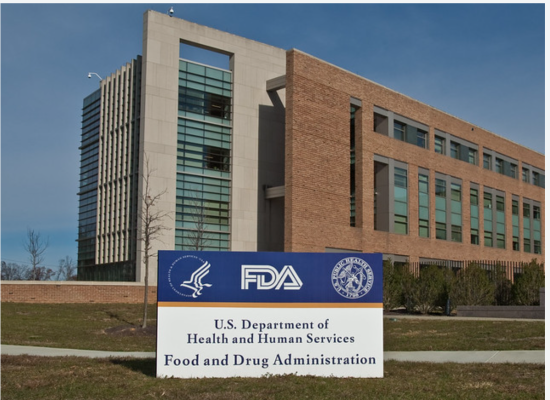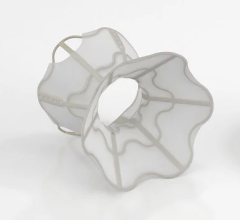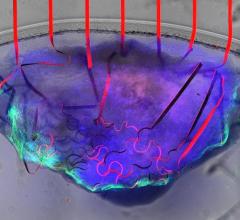
Daiichi Sankyo, Inc. and American Regent, Inc., a Daiichi Sankyo Group company, have announced that the U.S. Food and Drug Administration (FDA) approved INJECTAFER (ferric carboxymaltose injection) for the treatment of iron deficiency in adult patients with heart failure, making it the first and only intravenous (IV) iron replacement therapy indicated for adult patients with heart failure who have iron deficiency. Photo courtesy: FDA
June 6, 2023 — Daiichi Sankyo, Inc. and American Regent, Inc., a Daiichi Sankyo Group company, have announced that the U.S. Food and Drug Administration (FDA) approved INJECTAFER (ferric carboxymaltose injection) for the treatment of iron deficiency in adult patients with heart failure categorized as New York Heart Association class II/III to improve exercise capacity.1
The company reported that with this approval, INJECTAFER is now the first and only intravenous (IV) iron replacement therapy indicated for adult patients with heart failure who have iron deficiency.
“This new indication for INJECTAFER marks the first and only FDA approval of an intravenous iron replacement therapy for adult patients with heart failure, a progressive and chronic disease. Approximately 2.8 million U.S. adults are impacted by heart failure with iron deficiency or iron deficiency anemia, which can affect their daily lives and activities,”1-10 said Ravi Tayi, MD, MPH, Chief Medical Officer at American Regent, Inc. Tayi added, “INJECTAFER is the most extensively studied intravenous iron and this latest approval continues to build on the effective and proven use of INJECTAFER for adult and pediatric patients with iron deficiency anemia, and now for adult patients with heart failure who have iron deficiency.”11
The June 5 statement on the FDA approval also included the following information:
The New York Heart Association Functional Classification classifies patients’ heart failure based on the severity of their symptoms. Patients who have a slight or marked limitation of their physical activity due to fatigue, palpitation and/or dyspnea are considered to have class II or class III heart failure, respectively.12
The approval was supported by INJECTAFER data from a randomized controlled study, CONFIRM-HF (NCT01453608), that evaluated the efficacy and safety of INJECTAFER in adult patients with chronic heart failure and iron deficiency. Treatment with INJECTAFER significantly improved exercise capacity compared to placebo in iron deficient patients with heart failure.13 The safety results from the trial were generally consistent with the known safety profile of INJECTAFER. The most common treatment emergent adverse events (TEAEs) observed with INJECTAFER were headache, nausea, hypertension, injection site reactions, hypophosphatemia, and dizziness.14
INJECTAFER has been studied in more than 40 clinical trials that included over 8,800 patients worldwide.15
INJECTAFER has been approved in 86 countries since initial European Union approval in 2007 and is the most extensively studied IV iron.11,16
About INJECTAFER
INJECTAFER (ferric carboxymaltose injection) is indicated for the treatment of iron deficiency in adult patients with heart failure; iron deficiency anemia (IDA) in adult and pediatric patients 1 year of age and older who have either intolerance to oral iron or an unsatisfactory response to oral iron; and adult patients with IDA who have non-dialysis dependent chronic kidney disease.1 For patients weighing 50 kg (110 lbs) or more, it is given intravenously (into the vein) by a healthcare provider in two doses of 750 mg each at least seven days apart.1 For patients weighing less than 50 kg, each of the two doses is administered as 15 mg/kg body weight separated by at least seven days.1
INJECTAFER dosing for iron deficiency in adult patients with heart failure and New York Heart Association class II/III is based on patient weight (154.3 lbs) and hemoglobin level (ranges from <10 to 14-15 grams per deciliter (g/dl), starting at a single 500 mg dose up to two 1000 mg doses separated by six weeks). A maintenance dose of 500 mg may be administered at 12, 24 and 36 weeks for certain patients based on their serum ferritin levels and transferrin saturation value.1
Injectafer is manufactured and marketed under the name of Ferinject® (Ferric Carboxymaltose) by CSL Vifor outside of North America. CSL Vifor is a global partner of choice for innovative therapies in iron deficiency, dialysis and nephrology & rare disease. CSL Vifor specializes in strategic global partnering, in-licensing and developing, manufacturing and marketing pharmaceutical products for precision healthcare, aiming to help patients around the world lead better, healthier lives.
U.S. Important Safety Information for INJECTAFER
INDICATIONS
Injectafer® (ferric carboxymaltose injection) is indicated for the treatment of iron deficiency anemia (IDA) in adult and pediatric patients 1 year of age and older who have either intolerance or an unsatisfactory response to oral iron, and in adult patients who have non-dialysis dependent chronic kidney disease. Injectafer is also indicated for iron deficiency in adult patients with heart failure and New York Heart Association class II/III to improve exercise capacity.
IMPORTANT SAFETY INFORMATION
CONTRAINDICATIONS
Injectafer is contraindicated in patients with hypersensitivity to Injectafer or any of its inactive components.
WARNINGS AND PRECAUTIONS
Symptomatic Hypophosphatemia
Symptomatic hypophosphatemia with serious outcomes including osteomalacia and fractures requiring clinical intervention has been reported in patients treated with Injectafer in the post-marketing setting. These cases have occurred mostly after repeated exposure to Injectafer in patients with no reported history of renal impairment. However, symptomatic hypophosphatemia has been reported after one dose. Possible risk factors for hypophosphatemia include a history of gastrointestinal disorders associated with malabsorption of fat-soluble vitamins or phosphate, inflammatory bowel disease, concurrent or prior use of medications that affect proximal renal tubular function, hyperparathyroidism, vitamin D deficiency, and malnutrition. In most cases, hypophosphatemia resolved within three months.
Correct pre-existing hypophosphatemia prior to initiating therapy with Injectafer. Monitor serum phosphate levels in patients at risk for chronic low serum phosphate. Check serum phosphate levels prior to a repeat course of treatment in patients at risk for low serum phosphate and in any patient who receives a second course of therapy within three months. Treat hypophosphatemia as medically indicated.
Hypersensitivity Reactions
Serious hypersensitivity reactions, including anaphylactic-type reactions, some of which have been life-threatening and fatal, have been reported in patients receiving Injectafer. Patients may present with shock, clinically significant hypotension, loss of consciousness, and/or collapse. Monitor patients for signs and symptoms of hypersensitivity during and after Injectafer administration for at least 30 minutes and until clinically stable following completion of the infusion. Only administer Injectafer when personnel and therapies are immediately available for the treatment of serious hypersensitivity reactions. In clinical trials, serious anaphylactic/anaphylactoid reactions were reported in 0.1% (2/1775) of subjects receiving Injectafer. Other serious or severe adverse reactions potentially associated with hypersensitivity which included, but were not limited to, pruritus, rash, urticaria, wheezing, or hypotension were reported in 1.5% (26/1775) of these subjects.
Hypertension
In clinical studies, hypertension was reported in 4% (67/1775) of subjects in clinical trials 1 and 2. Transient elevations in systolic blood pressure, sometimes occurring with facial flushing, dizziness, or nausea were observed in 6% (106/1775) of subjects in these two clinical trials. These elevations generally occurred immediately after dosing and resolved within 30 minutes. Monitor patients for signs and symptoms of hypertension following each Injectafer administration.
Laboratory Test Alterations
In the 24 hours following administration of Injectafer, laboratory assays may overestimate serum iron and transferrin bound iron by also measuring the iron in Injectafer.
ADVERSE REACTIONS
Adults
In two randomized clinical studies [Studies 1 and 2], a total of 1775 patients were exposed to Injectafer, 15 mg/kg of body weight, up to a maximum single dose of 750 mg of iron on two occasions, separated by at least 7 days, up to a cumulative dose of 1500 mg of iron. Adverse reactions reported by >2% of Injectafer-treated patients were nausea (7.2%); hypertension (4%); flushing (4%); injection site reactions (3%); erythema (3%); hypophosphatemia (2.1%); and dizziness (2.1%).
Pediatric
The safety of Injectafer in pediatric patients was evaluated in Study 3. Study 3 was a randomized, active-controlled study in which 40 patients (1 to 12 years of age: 10 patients, 12 to 17 years of age: 30 patients) received Injectafer 15 mg/kg to a maximum single dose of 750 mg (whichever was smaller) on Days 0 and 7 for a maximum total dose of 1500 mg; 38 patients evaluable for safety in the control arm received an age-dependent formulation of oral ferrous sulfate for 28 days. The median age of patients who received Injectafer was 14.5 years (range, 1-17); 83% were female; 88% White and 13% Black. The most common adverse reactions (≥4%) were hypophosphatemia (13%), injection site reactions (8%), rash (8%), headache (5%), and vomiting (5%).
Patients with Iron Deficiency and Heart Failure
The safety of Injectafer was evaluated in adult patients with iron deficiency and heart failure in randomized controlled trials FAIR-HF (NCT00520780), CONFIRM-HF (NCT01453608) and AFFIRM-AHF (NCT02937454) in which 1016 patients received Injectafer versus 857 received placebo. The overall safety profile of Injectafer was consistent across the studied indications.
Post-Marketing Experience
The following adverse reactions have been identified during post approval use of Injectafer. Because these reactions are reported voluntarily from a population of uncertain size, it is not always possible to reliably estimate their frequency or establish a causal relationship to drug exposure.
The following adverse reactions have been reported from the post-marketing spontaneous reports with Injectafer: cardiac disorders: tachycardia; general disorders and administration site conditions: chest discomfort, chills, pyrexia; metabolism and nutrition disorders: hypophosphatemia; musculoskeletal and connective tissue disorders: arthralgia, back pain, hypophosphatemic osteomalacia; nervous system disorders: syncope; respiratory, thoracic and mediastinal disorders: dyspnea; skin and subcutaneous tissue disorders: angioedema, erythema, pruritus, urticaria; pregnancy: fetal bradycardia.
CLINICAL CONSIDERATIONS IN PREGNANCY
Untreated IDA in pregnancy is associated with adverse maternal outcomes such as postpartum anemia. Adverse pregnancy outcomes associated with IDA include increased risk for preterm delivery and low birth weight.
Severe adverse reactions including circulatory failure (severe hypotension, shock including in the context of anaphylactic reaction) may occur in pregnant women with parenteral iron products (such as Injectafer) which may cause fetal bradycardia, especially during the second and third trimester.
You are encouraged to report Adverse Drug Events to American Regent, Inc. at 1-800-734-9236 or to the FDA by visiting www.fda.gov/medwatch or calling 1-800-FDA-1088.
Please see accompanying full Prescribing Information and Medication Guide.
__________________
1 Injectafer [package insert]. Shirley, NY: American Regent, Inc.; May 2023.
2 MonoFerric [package insert]. Morristown, NJ: Pharmacosmos Therapeutics Inc.; February 2022.
3 Venofer [package insert]. Shirly, NY: American Regent, Inc.; October 2020.
4 INFeD [package insert]. Madison, NJ: Allergan; September 2021.
5 Ferrlecit [package insert]. Bridgewater, NJ: sanofi-aventis US LLC; March 2021.
6 Feraheme [package insert]. Waltham, MA: AMAG Pharmaceuticals, Inc.; June 2022.
7 Virani S, Alonso A, Aparicio H, et al. Heart Disease and Stroke Statistics – 2020 Update. Circulation. 2020; 141(9): e139-e596.
8 Ebner N, von Haehling S. Why is iron deficiency recognised as an important comorbidity in heart failure? Card Fail Rev. 2019;5(3):173-5.
9 Anand IS, Gupta P. Anemia and Iron Deficiency in Heart Failure: Current Concepts and Emerging Therapies. Circulation. 2018 Jul 3;138(1):80-98.
10 Data on file. Injectafer Heart Failure Demand Assessment in the Outpatient Setting Working Meeting; March 2022.
11 Data on file. Injectafer Studies. Daiichi Sankyo Inc., Basking Ridge, NJ.
12 Classes of Heart Failure. American Heart Association. May 2017. https://www.heart.org/en/health-topics/heart-failure/what-is-heart-failure/classes-of-heart-failure
13 Ponikowski P, van Veldhuisen DJ, Comin-Colet J, et al. Beneficial effects of long-term intravenous iron therapy with ferric carboxymaltose in patients with symptomatic heart failure and iron deficiency. Eur Heart J. 2015 Mar 14;36(11):657-68.
14Data on file. Module 5 (Integrated Summary of Safety for FCM). Daiichi Sankyo Inc., Basking Ridge, NJ.
15Data on file. PSUR (Periodic Safety Update Report), January 2017. Luitpold Pharmaceuticals, Inc., Shirley, NY.
16 Vifor Pharma Annual Report. https://www.viforpharma.com/investors/annual-report-2020. Accessed February 2023.
For information: www.daiichisankyo.com


 April 16, 2024
April 16, 2024 








